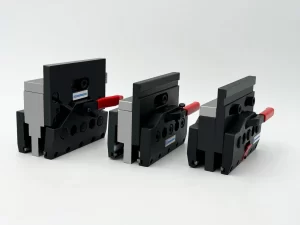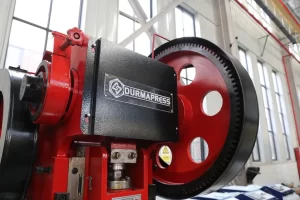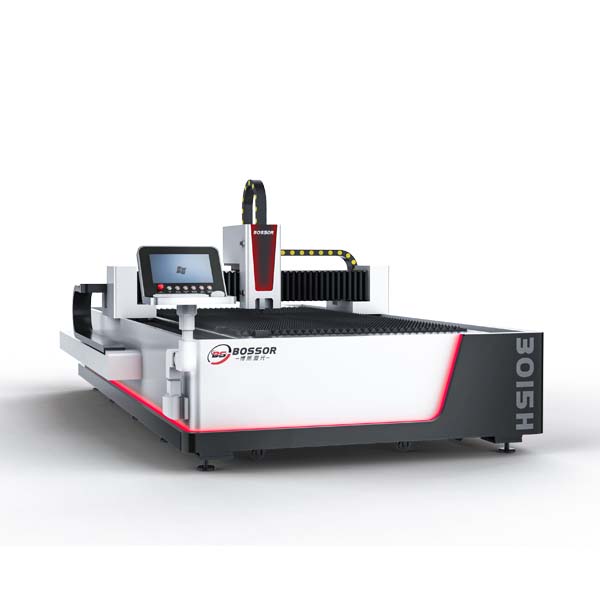
О нас
Durmapress specializes in designing, manufacturing, and selling various metal processing equipment, including bending machines, shears, punches, and laser cutting machines. The company was founded in 2014, with years of experience and technology accumulation. DurmaPress has become one of the well-known brands in China's metal processing machinery industry.
Свяжитесь с нами
Последние сообщения
Категории
Следуйте за нами
Еженедельное новое видео
Press brake tooling directly determines bending accuracy, repeatability, edge finish, and production efficiency. Selecting the right punches and dies—and maintaining them properly—is essential for consistent sheet metal forming quality. This guide explains the major types of press brake tooling, common materials, structural design differences, selection considerations, and long-term maintenance practices for industrial fabrication environments.

What Is Press Brake Tooling?
Press brake tooling refers to the punches and dies installed on the upper and lower beam of a press brake to bend sheet metal into specific angles or shapes.
A standard toolset includes:
- Punch – downward forming tool
- Die – V-block or specialized lower tool
- Tool holders / Clamping system
- Crowns / crowning system compensation tools
- Tooling accessories (radius inserts, hemming tools, gooseneck tools)
Tooling quality directly influences:
- Minimum bend radius
- Inside angle accuracy
- Springback control
- Tool life and surface wear
- Maximum achievable throughput
Press Brake Tooling Materials
Different tooling materials determine hardness, wear resistance, cost, and precision. Below is a practical reference table:
Table 1: Common Tooling Materials Compared
| Material Type | Hardness Level | Преимущества | Typical Use Cases |
|---|---|---|---|
| 42CrMo Alloy Steel | Medium–High | High strength, good durability, cost-effective | Standard punches/dies for mild steel & stainless steel |
| T8 / T10 Carbon Steel | Medium | Simple forming jobs, easy to machine | Budget tooling, light production |
| H13 Tool Steel (Heat-treated) | High | Excellent hardness, heat resistance, long service life | Heavy-duty bending, high tonnage jobs |
| Carbide Tipped Tools | Very High | Extreme wear resistance, perfect repeatability | High precision bending, thin stainless steel, mass production |
If you work with high-strength steel or thick plate, our hybrid press brake overview explains how advanced hydraulic-electric systems help protect tooling during heavy-duty bending.
Types of Press Brake Punches
Different punch geometries allow different bend shapes. The most common punches include:
Standard Punch (Straight Punch)
- General 90° or acute bends
- Suitable for most sheet metal fabrication
- Low cost and widely available
Gooseneck Punch
- Designed with a backward curve
- Allows bending return flanges without tool collision
- Essential for box bending and complex part geometry
Acute Angle Punch (30° / 60°)
- Creates acute bends in one stroke
- Often used for aerospace and decorative metalwork
Radius Punch
- Used to form bends with a large internal radius
- Prevents cracking on aluminum or high-strength steel
Hemming Punch
- Works with dedicated hemming dies
- For flattening bends (panel edges, cabinet doors)
Types of Press Brake Dies
Dies determine V-opening, radius, and bend style.
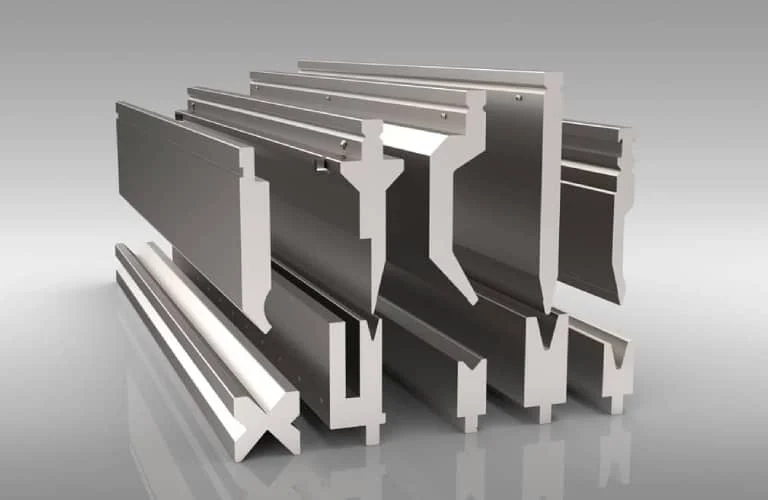
Single V-Die
- Most common
- Suitable for general sheet metal thickness
- Available in many V sizes (6 mm–100 mm)
Многослойная матрица
- Multiple V-openings in one die
- Flexible for different thickness materials
- Suitable for shops with broad job range
Acute Die (30°/45°)
- Produces precision acute angles
- Requires compatible acute punch
Radius Die
- Used for non-sharp bends
- Protects aluminum from cracking
Hemming Die
- For air-bending → flattening two-step process
How to Choose the Right V-Opening
Correct V-opening is critical for bending force and angle accuracy.
General rule:
V-opening = 8 × sheet thickness (t)
Table 2: Recommended V-Opening by Thickness
| Sheet Thickness (mm) | Recommended V (mm) | Notes |
|---|---|---|
| 0.5–1.0 | 6–8 | Точная гибка |
| 1.5–2.0 | 12–16 | General fabrication |
| 3.0–4.0 | 24–32 | Reduces tonnage requirement |
| 6.0–8.0 | 48–64 | Heavy-duty applications |
Too small V = cracking risk
Too large V = poor angle accuracy
Tooling Standards: European vs. American vs. WILA-Style
Press brake tooling systems follow several international standards, each optimized for different levels of precision, flexibility, and production requirements. Understanding these standards is essential for ensuring compatibility with your press brake and long-term tooling strategy.To select compatible tooling and clamping systems, refer to our comparison of metal processing machines commonly used in fabrication workshops.
European Type Tooling (Euro / Promecam Style)
European tooling is the most widely used in modern CNC press brakes due to its modularity and quick-change capability.
Key Characteristics:
- Lightweight segmented tools for fast setup
- High compatibility with WILA/Trumpf-style clamping systems
- Excellent for shops requiring frequent tooling changes
- Supports precision-ground tools for high repeatability
Best For:
Job shops, high-mix/low-volume production, and CNC press brakes requiring flexibility.
American Type Tooling
American tooling is known for simplicity and structural robustness. It uses one-piece long tools rather than short, segmented punches and dies.
Key Characteristics:
- High rigidity and durability
- Lower tooling costs compared to European standard
- Less flexible due to longer tool sections
- More suitable for older hydraulic press brakes
Best For:
Heavy-duty bending, long straight bends, and cost-sensitive operations.
WILA / Trumpf Precision Tooling
This is the premium, high-precision tooling ecosystem used in advanced CNC press brakes.
Key Characteristics:
- Extremely high accuracy (ground tolerance typically around ±0.01 mm)
- Quick-release hydraulic or mechanical clamping
- Suitable for robotic bending and automated production
- Long service life with minimal wear
Best For:
High-volume production lines, aerospace-grade precision, automated bending cells.
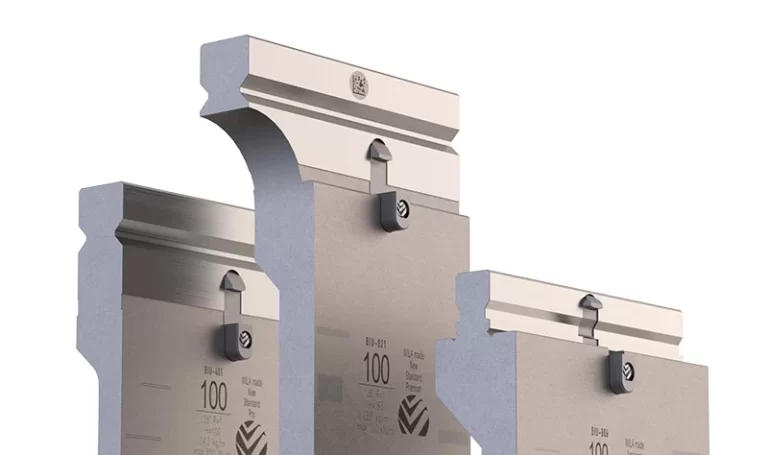
Tooling Maintenance & Longevity Guide
Tooling performance and lifespan greatly depend on proper maintenance. A structured maintenance program can extend tooling life by 30–50%.
Pre-Shift Cleaning & Surface Care
- Remove dust, chips, and burrs from tooling surfaces
- Clean with approved non-corrosive solutions
- Keep dies free from oxide buildup to ensure accurate seating
Controlled Lubrication
- Apply light oil on contact surfaces to reduce friction
- Avoid excess lubrication → may cause sheet surface contamination
- Never lubricate WILA-style clamping areas unless specified
Safe Handling & Storage
- Use dedicated tooling racks or protective cases
- Do not drop or impact tooling—micro-cracks lead to poor angles
- Label and categorize tools by type and height for fast retrieval
Alignment & Crowning Verification
Misalignment causes torsion on tools and uneven wear.
- Inspect punch and die alignment before production
- Check crowning system performance for long parts
- Replace damaged holders immediately to avoid tool deformation
Edge Sharpening & Life Restoration
Some tools allow regrinding to restore performance.
- Only regrind carbon steel or certain alloy steel tools
- Avoid over-sharpening → shortens tool height and causes angle deviation
- Check tool height uniformity after sharpening
Common Tooling Defects & Troubleshooting
| Defect | Possible Causes | Решения |
|---|---|---|
| Cracking during bend | V too small / punch too sharp | Choose larger V or radius punch |
| Angle inconsistency | Tool wear / incorrect crowning | Inspect tools; adjust crowning |
| Surface marks | Hard punch on soft metal | Add radius insert |
| Excessive springback | Material too strong / tooling mismatch | Use acute tooling or narrower V |
Заключение
Press brake tooling is a critical factor in achieving precision metal bending. Understanding punch and die types, selecting the correct materials, calculating proper V-openings, and performing regular maintenance will significantly improve product quality and tooling lifespan. Whether you operate a job shop or a high-volume CNC bending line, investing in the right tooling system is essential for consistency, speed, and long-term reliability.
ЧАСТО ЗАДАВАЕМЫЕ ВОПРОСЫ
Consider material, thickness, bend radius, and part geometry. Aluminum needs radius dies; stainless steel requires hardened tooling.
Single V, Multi-V, Acute (30°/45°), Radius, Hemming, and Offset dies.
Clean, lightly lubricate, store properly, check alignment, and sharpen carefully if needed.
No. Different metals need specific dies for best results and longer tool life.


